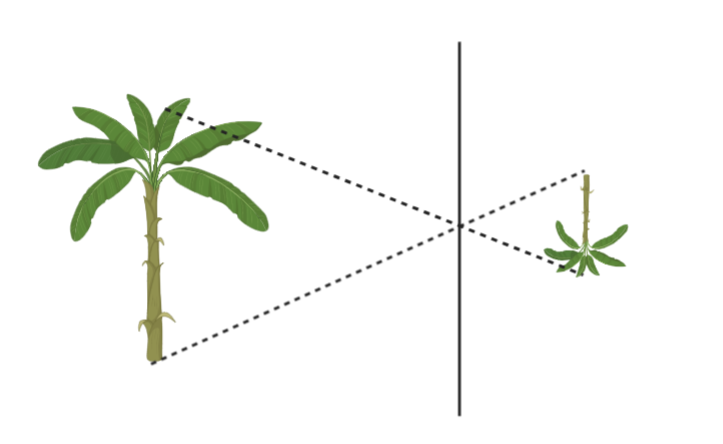
Images are inverted in a pinhole camera because:
(A) Light travels in a straight line
(B) Images are always inverted
(C) Images get inverted when light travel through a hole
(D) There is no specific reason
Answer
123.3k+ views
Hint An image formed by reflection can be real or virtual. A real image occurs when light rays actually intersect at the image, and become inverted, or turned upside down. A virtual image occurs when light rays do not actually meet at the image but appear to be met.
Complete step by step answer:
The light rays that come from the object get reflected from the plane mirror and reach our eyes. As they touch eyes our brain feels that the reflected ray is coming from inside the mirror. That is why the image of the object seems to be laterally inverted.

Such upside down inversion also occurs when you see yourself in a spoon on the concave side.
This phenomenon occurs obeying laws of reflection and laws of rectilinear propagation; which is light travels in a straight line.
Hence option A is correct.
Note Magnifying glasses are made of convex lenses. A convex lens can make objects look larger because it disperses the light. When objects are magnified, they are within the focal length of the magnifying glass. The focal length is defined as the distance between the center of the lens and its focus, the point where an object can be viewed clearly through a lens.
Complete step by step answer:
The light rays that come from the object get reflected from the plane mirror and reach our eyes. As they touch eyes our brain feels that the reflected ray is coming from inside the mirror. That is why the image of the object seems to be laterally inverted.

Such upside down inversion also occurs when you see yourself in a spoon on the concave side.
This phenomenon occurs obeying laws of reflection and laws of rectilinear propagation; which is light travels in a straight line.
Hence option A is correct.
Note Magnifying glasses are made of convex lenses. A convex lens can make objects look larger because it disperses the light. When objects are magnified, they are within the focal length of the magnifying glass. The focal length is defined as the distance between the center of the lens and its focus, the point where an object can be viewed clearly through a lens.
Recently Updated Pages
JEE Main 2025 - Session 2 Registration Open | Exam Dates, Answer Key, PDF

How to find Oxidation Number - Important Concepts for JEE

How Electromagnetic Waves are Formed - Important Concepts for JEE

Electrical Resistance - Important Concepts and Tips for JEE

Average Atomic Mass - Important Concepts and Tips for JEE

Chemical Equation - Important Concepts and Tips for JEE

Trending doubts
JEE Main Login 2045: Step-by-Step Instructions and Details

JEE Main 2023 January 24 Shift 2 Question Paper with Answer Keys & Solutions

Charging and Discharging of Capacitor

Physics Average Value and RMS Value JEE Main 2025

JEE Main 2023 January 25 Shift 1 Question Paper with Answer Keys & Solutions

JEE Main 2022 June 29 Shift 2 Question Paper with Answer Keys & Solutions

Other Pages
JEE Advanced 2025: Dates, Registration, Syllabus, Eligibility Criteria and More

JEE Main Course 2025: Get All the Relevant Details

JEE Advanced 2025 Revision Notes for Practical Organic Chemistry

Free Radical Substitution Mechanism of Alkanes for JEE Main 2025

JEE Advanced 2025 Revision Notes for Physics on Modern Physics

JEE Main 2022 July 28 Shift 2 Question Paper with Answer Keys & Solutions




